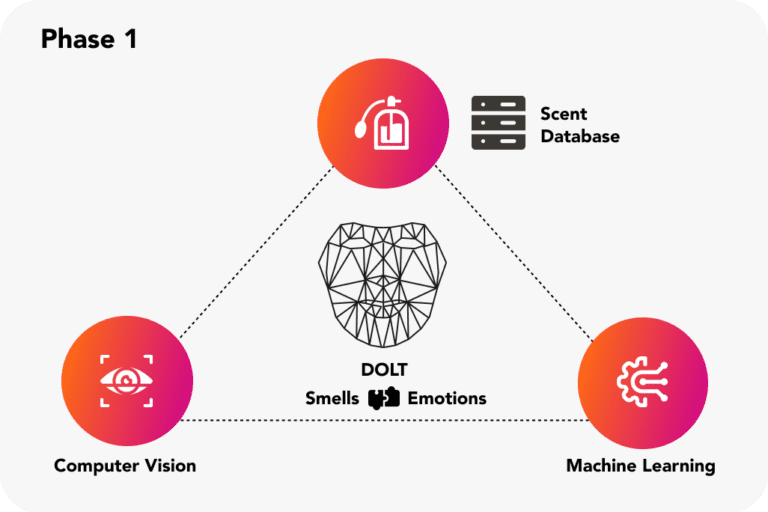The link between smell and emotion has long been established. Now, a new joint venture between Uniphore and a major European bioengineer plans to explore how smell—specifically digital olfactory data—can impact emotion AI. Sound stranger than fiction? Read on for the full story—and what this exciting development means for enterprise customer experience (CX) applications.
 According to The Harvard Gazette, “smells are handled by the olfactory bulb, the structure in the front of the brain that sends information to the other areas of the body’s central command for further processing. Odors take a direct route to the limbic system, including the amygdala and the hippocampus, the regions related to emotion and memory.”
According to The Harvard Gazette, “smells are handled by the olfactory bulb, the structure in the front of the brain that sends information to the other areas of the body’s central command for further processing. Odors take a direct route to the limbic system, including the amygdala and the hippocampus, the regions related to emotion and memory.”
It’s no wonder then that scent design has gone far beyond department store fragrance shelves. Over the past few years, “scent branding” has become big business, with several of today’s industry leaders exploring the impact of “olfactory engagement” on customer experience. According to another Harvard publication, The Harvard Business Review, “scented environments have been shown to improve the perception of product quality; increase purchase intent, average unit sales; and boost the willingness of consumers to pay more for a product.”
So, what does this have to do with artificial intelligence? A lot, actually. Just as emotion AI can detect valuable cues from facial expressions, vocal tone and inflection, new evidence suggests that smells are just as rich—if not richer—in actionable insights. Welcome to the exciting world of digital olfaction.
Harnessing the Power of Smell through Digital Olfaction AI
Digital olfaction uses highly sophisticated biosensors to “read” smells and imitate human response based on a large dataset. Using machine learning, this data can then teach a computer model to smell with relative ease. These models mimic the olfactory circuits that the brain uses to process different smells. By adding emotion AI to the equation, Uniphore aims to take the process one step further: identifying which smells trigger which emotions—and leveraging that data in remote customer engagements.
Partnering with L’Institut de Fragrance, Flanders-Ypres (IFFY), a Belgian-based olfactory bioengineer behind many of today’s most recognizable scents, Uniphore will begin integrating olfaction AI within its popular X-Platform and Q for Sales. “We are incredibly excited to see how the marriage of digital olfaction and emotion AI will positively impact customer experience and sales,” says Thierry LeFou, Principle Olfactory Scientist at IFFY. “As we all know, data is everything today. By adding a valuable layer of sensory data to Uniphore’s already data-rich solution, users will soon be able to access the full spectrum of customer emotion—from the visual to the behavioral to the olfactory.”
How Will the Technology Work?
The joint Uniphore-IFFY solution will take a two-phase approach. The first phase combines Uniphore’s industry-leading computer vision and machine learning capabilities with IFFY’s extensive scent database. Similar to the facial mapping technology used in Q for Sales, the new solution will rely on a user’s desktop camera to capture an “olfactory imprint” based on environmental identifiers. These identifiers will then be analyzed by using digital olfaction learning technology (DOLT) that matches smells with the emotions they evoke.
How does DOLT know which smells evoke which emotions? With generative AI. “We use an open-sourced generative AI model to match common smells with the emotions most frequently associated with them,” said Gabriel Sciocco, Digital Olfaction Product Engineer at Uniphore. “In the same way that Chat GPT generates written content by patching together similar content from a large, open dataset, DOLT’s generative AI looks for commonalities specific to smell.” And with IFFY’s massive dataset, built on more than two decades of bioengineered scent design, the results are remarkably accurate.


Just how can scent-based generative AI improve customer experience? Using DOLT, customer service and/or sales representatives will be able to tell if environmental factors are impacting a given interaction. (For example, if a nearby cleaning product or coworker’s cologne is contributing to a customer’s frustration or emotional distress.)
Using this valuable olfactory data, representatives can adjust their sales or service tactics, as needed (i.e., suggesting a new “scent neutral” location). Businesses can also use this data to further engage particularly promising prospects and high-value customers (Phase 2). By comparing interaction data against IFFY’s scent database, olfactory-enabled businesses can recommend new scents designed to eliminate “emotional dissonance.” (Many can even be ordered on a customer’s or client’s behalf using Instacart and other delivery services.)
When Will the Technology be Available?
Uniphore’s new digital olfaction technology is currently undergoing beta testing—and showing promising preliminary results. While an official release has yet to be announced, those interested in trying the beta version of the product are encouraged to look at today’s date.


